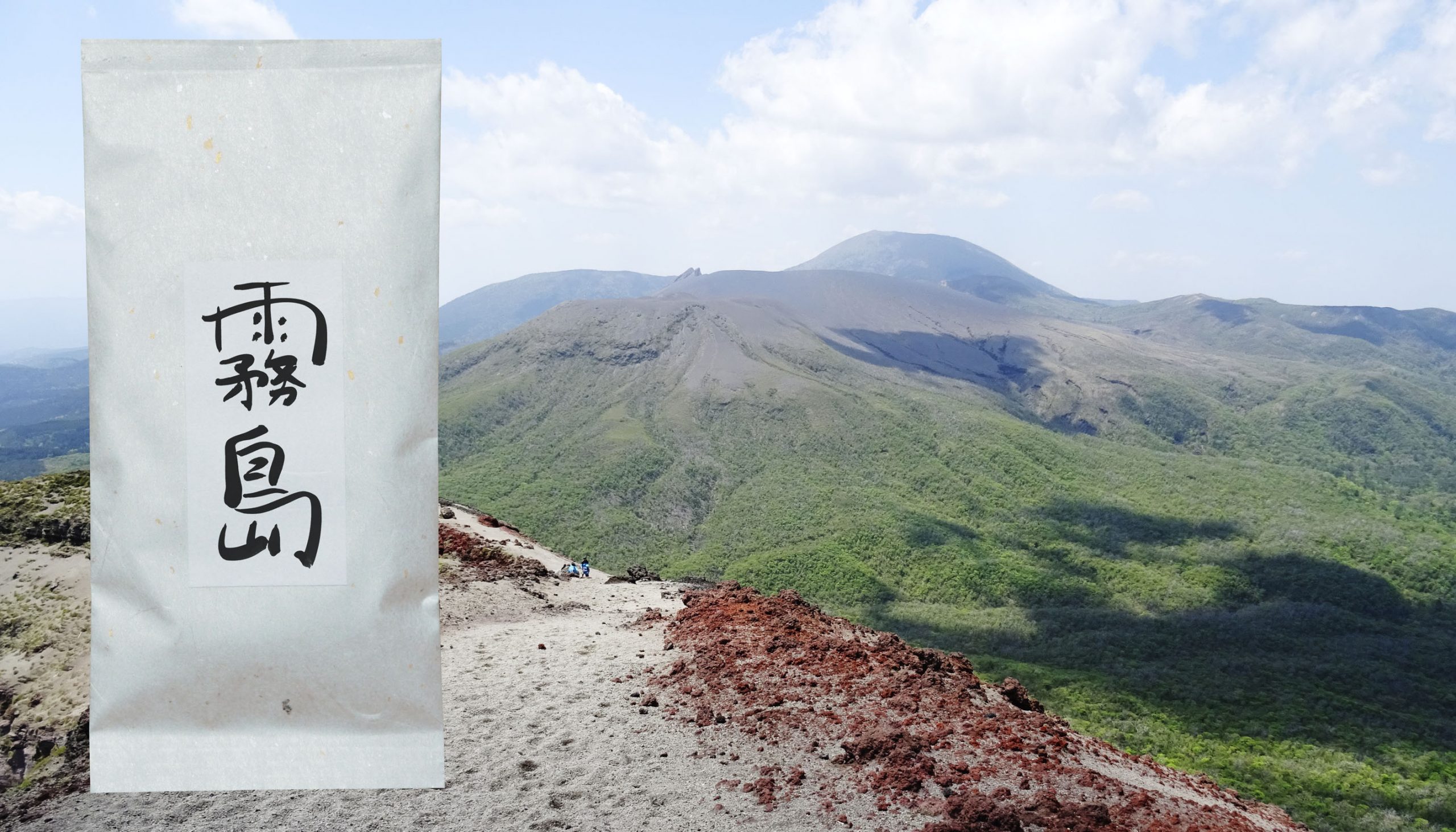This year, 2017, it is exactly 10 years since we first came to Kirishima. How this happened is probably an interesting story in itself. It was the time shortly before we started our own tea import and wholesale of Japanese green tea: In some tea shops where we bought Japanese green tea for ourselves, there were some elegant green teas from Kirishima. Moreover they were organically grown teas, which was rather an excemption for Japanese tea at that time. As students we had almost no money, so we only treated ourselves to one of these teas a single time for a special occasion. However, the atmosphere of the tea, and everything we associated with „tea from Kirishima“ stayed in our memory. And it shaped our image of Kirishima before we even had a chance to travel to Kirishima for the first time by ourselves.

KIRISHIMA – View from the Karakuni volcano crater to Takachihonomine
In 2007 finally we had the chance to stay in Japan for a longer time, thanks to our work for a market research about organic shops in Tokyo. We used our only three free days to take a Shinkansen express train to Kyushu, where we travelled as fast as possible into the direction of Kirishima. We looked for a suitable train station to discover one of the organic Kirishima tea gardens, by foot if possible. However, we had no idea where exactly the organic tea gardens in Kirishima were located. So we got off the train in the middle of the mountains, because we had heard that the garden was in the middle of the Kirishima mountains. Just as we started to get some orientation about the area, it started to rain very heavily. We quickly understood that we would not have the luck to find a tea garden in Kirishima that day. But we did not want to give up, and at least we wanted to discover the Kirishima mountains a little bit. So we simply walked up-hill, hoping to further enter the volcano landscape of the Kirishima mountains. Yet, it was raining more and more, and we had no other option but to look for a shelter.

This shelter, as fortune would have it, was the pottery atelier of NARIEDA Shinichiro, which thus we had the honour to discover in 2007. So, visiting Narieda Shinichiro today, we celebrated the 10-years-anniversary of our first meeting in 2007, and of our cooperation with his wonderful ceramics, which we since then received from him and could make available to many art and tea enthusiasts in Europe. During today’s visit at the place of the 67-years-old artist NARIEDA, besides celebrating the 10th anniversary of our first meeting, we also had the opportunity to look at some of his special works. From those, besides three matcha bowls, he also entrusted one of his larger Kabin (vase) to us, for which the ceramist is famous in his home country.

There is so much to write about Kirishima, art from Kirishima, and tea from Kirishima, that the time for today’s blog entry is really to short. Yet two points just have to be mentioned. In 2007 we were incredibly lucky to meet ceramist NARIEDA Shinichiro, but our search for the aforementioned „Kirishima organic tea gardens“ was not so succesful. So we kept our eyes open in the following years, and in 2014 finally meet Osamu Hayashi, father of Shutaro Hayashi, who then ran the family’s tea garden in the 4th generation. Good timing, because in the meantime the management of the family garden passed to son Shutaro Hayashi, who is in the same age as us. This is a very exciting and enriching experience for us, because usually tea producers in Japan are rather in the age of our parents.

Now, in the year 2017, on the occasion of our now 3-years-long cooperation, there is something special: The “KIRISHIMA ARACHA SHINCHA – Kabuse Asatsuyu cultivar”. As the “Asatsuyu cultivar” in the name says, it is a Shincha from the tea bush varietal Asatsuyu, which moreover has three other special features: The Asatsuyu bushes are shaded [Kabuse], and they will come to us in Europe in the condition of Aracha [non-finalised green tea], to have a 100 percent Shincha taste in the sense of a very young tea. Moreover it is the “children” of Asatsuyu bushes, which are genetically not absolutely identical with their “parents” [this is called Mishou in Japanese]. Thus they can only be found in the tea garden of Shutaro Hayashi. So, it is a Kirishima Aracha Shincha from Kabuse Mishou Asatsuyu cultivar, and there can be no other comparable Shincha like it. Well, and there is only 10kg – let’s see if there is anything left for us to try it ourselves. If not, we are looking forward to hearing the feedback of those who will have had the chance to try the KIRISHIMA ARACHA SHINCHA – Kabuse Asatsuyu cultivar 2017.

Certainly our tea travels in Japan are often so hectic, that there is hardly any time to really peacefully enjoy all the exciting and joyful moments that happen here every day. Yet, we try to at least keep one day free every year, to go for a mountain hike, which is really dedicated to enjoying the landscape and the atmosphere of this enchanted surrounding. A wonderful choice for this is a climb on one of the volcanoes or volcano craters of the chain of Kirishima volcanoes. While a “mountain climb” even in our ears sounds like “hiking”, and maybe sounds like a nice leisure activity, but not so much like a special inspiration, each time we had the chance to, we understand that a volcanoe hike on the chain of Kirishima volcanoes is one of the most inspiring moments ever. This is also how the Kirishima print above was born (a risography print with 25 pieces). If you are interested in where it is available please contact office@marimo.eu.